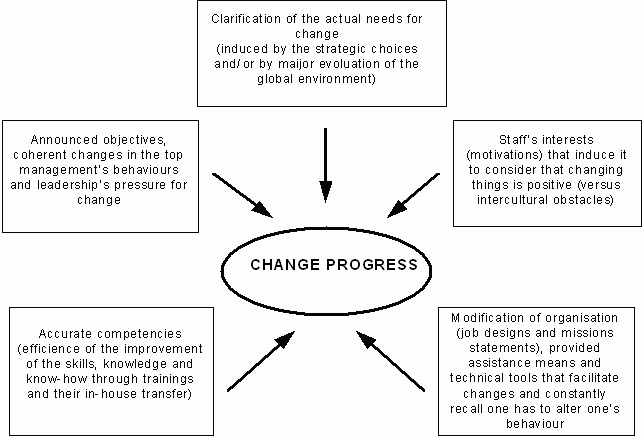Methodology for changing C.I.S. banks
Category: Bank Management
This third part of the handbook is meant to suggest a coherent overall approach of the management of the changes that have to be completed in the C.I.S. banks, suggesting improvements to be implemented, as much as possible in terms of ways to do things: how to manage to achieve efficiently the required changes?
Conceptual framework of change methodologies
We have seen, during the fist part of this handbook, that C.I.S. banks have to achieve different natures of changes:
Some of them have already succeeded in passing from a centralised planned context into a open market environment. For their future, a pessimistic conception is that, at least in some places, they could have to change back.
Anyhow, to-day, the most frequent situation in C.I.S. banks is to have to change to recovery from an unbalanced and risky situation.
Despite of what, C.I.S. banks should prepare to future international competitiveness.
To achieve such evolutions, the required changes could be more or less deep. For instance, as EBTRA’s Management of Change module upon « Change management methodologies » shows « the expected changes can be at different levels: of course, technical, economic/commercial and social changes vary in importance and depth. » It is possible to identify at least seven levels, some banks have to modify:
— their behaviours (modes of actions),
— their tools,
— their activities (clients, products, packaging, advertising, etc.),
— their methods, techniques, rules or working processes (the way the things are done and used), and even their management systems, for example concerning human resources management (for instance, the opportunities for career development they offer to their staff),
— their organisation (distribution) of the work (« what is done by whom » may need to change, inducing a major modification in the required competencies),
— their purposes, aims, objectives, and even business strategies or their structures,
— their basic conceptions, beliefs, attitudes, values and culture or even their own existence.
The depth of changes increases as one moves down the list, and, in general, one should not promote deeper changes without first exploring change at lower level.
Despite of what, due to the urgency and the importance of their environmental challenges, C.I.S. banks could have, in fact, successively, to:
— chose new strategies, specializing in attractive markets or activities, lobbying with authorities, negotiating financial agreements with other banks, concentrating through mergers or acquisitions, constituting prudential reserves, etc.,
— invest to enhance their means (E.D.P. equipments,), modify their structure and/or their organisation (centralizing, using external facilities through outsourcing, etc.) and implement tighter procedures and controls (accounting),
— reinforce their management tools and practices (planning, budget, follow-up of results,) and communicate an improved (international) image,
— develop new actions: new offers to new clients, adjust their pricing, simplify their methods to reduce their costs, adapt their customer services and adopt new selling practices.
Changing pace and rhythm?
Of course, the approaches have to be adapted to the importance and the nature of the changes sought for. Some radical modifications, such as sharp cuts of the organisational structure, are not to be conducted in the same way as deep transformations that can require a gradual change.
However, even if deeper changes require a more careful approach, our experience shows the same kind of methodology apply (to a higher or lesser degree) to all situations and can therefore be useful in nearly every circumstances.
Global perception of the system that has to be changed
As EBTRA’s Management of Change module « Change management methodologies » notices, « in the C.I.S., even though the level of change in banks varies according to the type of bank and the policies of their founders, banks can be considered as “systems” within a national and international context
As with any living organism, banks react to the changes in their environment, by modifying their operations and thus enabling them to adapt. These reactions will, in turn, affect the banks’ operating environment
Within any system, when one element changes, the other elements may be affected. Thus, the evolution of new technologies and the development of the market economy induce internal changes in the banking industry to which bank management needs to react
All these changes are interdependent and need to be addressed simultaneously, even if one cannot change everything at once ».
We do think, from our experience of having conducted many changes within companies of different sectors in several countries, that to be able to achieve a change successfully, it is useful to understand the « system » that has to be changed, and, mainly, its five major components:
The components of a general pattern of the factors that determine changes
Let us now come back to the previously mentioned three components of any project management.

